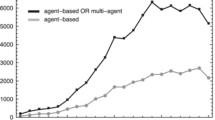Abstract
Nested Petri nets (NP-nets) is an extension of Petri net formalism within the “nets-within-nets” approach, when tokens in a marking are Petri nets wich have autonomous behavior and synchronize with the system net. The formalism of NP-nets allows modeling multi-level multi-agent systems with dynamic structure in a natural way. Currently there is no tool support for NP-nets simulation and analysis. The paper proposes translation of NP-nets into colored Petri nets and using CPN Tools as a virtual machine for NP-nets modeling, simulation and automatic verification.
Similar content being viewed by others
References
ter Hofstede, A.H.M., van der Aalst, W.M.P., Adams, M., and Russell, N., Modern Business Process Automation: YAWL and Its Support Environment, Springer, 2010.
van der Aalst, W.M.P., Stahl, C., and Westergaard, M., Strategies for Modeling Complex Processes Using Colored Petri Nets, ToPNoC V. LNCS 6900, 2012, pp. 265–291.
Bashkin, V.A. and Lomazova, I.A., Resource driven automata nets, Fundamenta Informaticae, 2011, vol. 109, no. 3, pp. 223–236.
Bashkin, V.A. and Lomazova, I.A., Modelling multiagent systems with the help of generalized nets of active resources, Cybernetics and Systems Analysis, 2011, vol. 47, no. 2, pp. 202–209.
Bashkin, V.A. and Lomazova, I.A., Cellular resource-driven automata, Fundamenta Informaticae, 2012, vol. 120, nos. 3–4, pp. 243–257.
Bashkin, V.A., Lomazova, I.A., and Novikova, Y.A., Timed resource driven automata nets for distributed realtime systems modelling, Proc. of PACT 2013, LNCS 7979, 2013, pp. 13–25.
Bednarczyk, M.A., Bernardinello, L., Pawlowski, W., and Pomello, L., Modelling mobility with Petri Hypernets, Recent Trends in Algebraic Development Techniques, LNCS 3423, 2005, pp. 28–44.
Bocăneală, C., Modeling inteligent systems with level Petri nets, Annals of Dunarea de Jos Year, 2008, vol. 31, no. 2, pp. 31–36.
Chang, L., He, X., Lian, J., and Shatz, S., Applying a nested Petri net modeling paradigm to coordination of sensor networks with mobile agents, Proc. of Workshop on Petri Nets and Distributed Systems, Xian, China, 2008, pp. 132–145.
Dvoryansky, L.V. and Lomazova, I.A., On compositionality of boundedness and liveness for nested Petri nets, Fundamenta Informaticae, 2012, vol. 120, nos. 3–4, pp. 277–295.
van Hee, K., Lomazova, I. A., Oanea, O., Serebrenik, A., Sidorova, N., and Voorhoeve, M., Nested nets for adaptive systems, Proc. ICATPN, LNCS 4024, 2006, pp. 241–260.
van Hee, K., Oanea, O., Serebrenik, A., Sidorova, N., Voorhoeve, M., and Lomazova, I.A., Checking properties of adaptive workflow nets, Fundamenta Informaticae, 2007, vol. 79.
Hoffmann, K., Ehrig, H., and Mossakowski, T., High-level nets with nets and rules as tokens, Proc. ICATPN, LNCS 3536, 2005, pp. 268–288.
Jensen, K. and Kristensen, L.M., Coloured Petri Nets: Modelling and Validation of Concurrent Systems, Springer, 2009.
Jensen, K., Kristensen, L.M., and Wells, L., Coloured Petri nets and CPN tools for modelling and validation of concurrent systems, International Journal on Software Tools for Technology Transfer, 2007, vol. 9, nos. 3–4, pp. 213–254.
Köhler, M. and Farwer, M., Object nets for mobility, Proc. ICATPN, LNCS 4546, 2007, pp. 244–262.
Köhler-Bussmeier, M., Hornets: nets within nets combined with net algebra, Proc. Applications and Theory of Petri Nets, LNCS 5606, 2009, pp. 243–262.
Lomazova, I.A., Nested Petri nets-a formalism for specification and verification of multi-agent distributed systems, Fundamenta Informaticae, 2000, vol. 43, nos. 1–4, pp. 195–214.
Lomazova, I.A., Nested Petri nets: multi-level and recursive systems, Fundamenta Informaticae, 2001, vol. 47, nos. 3–4, pp. 283–293.
Lomazova, I.A., Modeling dynamic objects in distributed systems with nested Petri nets, Fundamenta Informaticae, 2002, vol. 51, nos. 1–2, pp. 121–133.
Lomazova, I.A., Nested Petri nets for adaptive process modeling, Pillars of Computer Science: Essays Dedicated to Boris (Boaz) Trakhtenbrot on the Occasion of His 85th Birthday, LNCS 4800, 2008, pp. 460–474.
Mascheroni, M. and Farina, F., Nets-Within-Nets paradigm and grid computing, Transactions on Petri Nets and Other Models of Concurrency V, LNCS 7347, 2012, pp. 201–220.
Valk, R., Petri nets as token objects: an introduction to elementary object nets, Proc. of ICATPN’98, LNCS 1420, 1998, pp. 1–25.
CPN Tools Manual: Nondeterministic nets, http://cpntools.org/documentation/tasks/verification/nondeterministic-nets.
Author information
Authors and Affiliations
Corresponding author
Additional information
The article is published in the original.
About this article
Cite this article
Dworzański, L.W., Lomazova, I.A. CPN tools-assisted simulation and verification of nested Petri nets. Aut. Control Comp. Sci. 47, 393–402 (2013). https://doi.org/10.3103/S0146411613070201
Published:
Issue Date:
DOI: https://doi.org/10.3103/S0146411613070201




